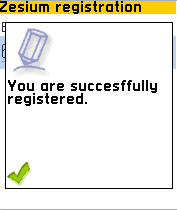
|

|

|
| Home |
| Short biography |
| Projects |
| Additional skills |
| Fields of interest |
| Contact |
| Links |
Visitor counter : 






|
| © since 2003 Igor Galić |
ParagrafLex Legal system
| Jun 08 - Now |
Paragraf Lex: Legal Distribution System |
|
LegalAct Distribution is an electronic collection of laws and regulations documents, official opinions, case law studies, the judicial practices as well as the model of legal acts of European legislation and other foreign rights, tariffs and similar documents of interest to companies in order to legally conduct their businesses. The solution is the system consisted of legal database as central storage place for all legal documents and several different applications with main purpose to provide fast search, easy access, visibility and up-to-date documents for a customer. There are 4 realizations of this subsystem:
Please visit website http://paragraf.rs |
mBid24
Jun 05 - Nov 05  |
mBid24: eBay client application for mobile phone |
|
mBid24 is client-server application that allows using of eBay database on mobile device. This project consists of two main applications rich client application and server application. Client application is written in Micro Java (J2ME) so it is easily ported on many different mobile device platforms (Nokia, SonyEricsson, Motorola, and Siemens etc). Server application is also written in Java SE, using servlet, JSP and JSTL technology. I was Lead responsible for server application. My job included detailed design and implementation of complete server solution. There were four main interfaces are made:
Please visit website and try our exciting application at http://www.zesium.com |
PoC Client 1.0
|
Apr 04 - Nov 04 |
FTS Project: PoC Client 1.0 |  |
|
Team member responsible for HTTP, RTP and RTCP components. The PoC Client 1.0 has been developed in conformance with the IETF, 3GPP, OMA (NEMS) and Siemens Specification documents. The PoC defines three communication channels (SIP, HTTP and RTP) and several applications: PoC Call Control (SIP, RTP/RTCP), Presence (SIP), Contact Management (HTTP), Chat (SIP) and Instant Messaging (SIP). The project is written in Embedded C++ using conventions for achieving the portability. The project has been developed in cooperation with the Zesium mobile, Germany. |
||
| Lead Responsible for HTTP/1.1 subsystem design and implementation. HTTP/1.1 subsystem is done according to standards proposed in RFC 2616 Hypertext Transfer Protocol -- HTTP/1.1, June 99 and RFC 2617 HTTP Authentication: Basic and Digest Access Authentication, | ||
| Lead responsible for the RTP and RTCP subsystem components. These protocols are done as recommended in RFC 3550 RTP: A Transport Protocol for Real-Time Applications, July 2003 and RFC 3551 RTP Profile for Audio and Video Conferences with Minimal Control, July 2003 | ||
| Responsible for the specification and design of RTP stream handling. The problem of memory copying minimization has been solved. |
IMS Client 2.0
| Sept 03 - Mar 04 | FTS Project: IMS Client 2.0 |  |
| Team member responsible for HTTP subsystem component. The IMS Client 2.0 has been developed in conformance with the IETF, 3GPP and Siemens Specification documents. The IMS defines two communication channels (SIP and HTTP) and several applications: Presence (SIP), Address Book (HTTP), Chat (SIP) and Instant Messaging (SIP). | ||
| Lead Responsible for HTTP/1.1 subsystem design and implementation. HTTP/1.1 subsystem is done according to standards proposed in RFC 2616 Hypertext Transfer Protocol -- HTTP/1.1, June 99 and RFC 2617 HTTP Authentication: Basic and Digest Access Authentication, | ||
| Contributed in parser/encoder component design and implementation. These components are: SIP, HTTP, XML parsers and encoders. I have experience in writing grammar for parser components, implementation in embedded C++ and testing for both encoders and parsers. |
ASM for pattern recognition
| Jan 03 - Mar 04 | Project: ASM for pattern recognition | |
| Active Shape Model for pattern recognition project defines application that uses ASM in robotic vision for detecting certain shapes in images. This project is done as part of the postgraduate studies. Purpose of this project is to show that Active Shape Modle can be used as fast pattern recognition filtar. This project consisted of several tasks. First one is to invastigate all concurent filters to estimate their processing speed and posibilty to use those in real-time processing. Next is to invastigate a divergetion possibilities of this algorithm and the last task was to make design and implementation of this algorithm. |
|
|
Multirate Digital Signal Processing
Feb 03 - Mar 03    |
Project: Multirate Digital Signal Processing |
| This project is done as part of postgraduate studies. Aim of this project is to show how change in sampling rate afects the propagation of the digital signal. This project propose the best solution to that problem. Application is done in C++ using MFC library. There is four part of the project, each is done as separete part (module). All of these modules are configurabile so test could be performed on different signal types.
|
|
| Free Application Download |
FIRE fuzzy filter for image processing
Mart 02 - Sep 02 |
Graduate theses: FIRE fuzzy filter for image processing | |
|
Purpose of this project was to make a cross reference of the noise removal and edge detecting filtars in a image processing. Also the task was to make a parallel and to compare every filtar to FIRE filtar that uses fuzzy logic. This project conssisted of several stages. |
See FIRE filter presentation (Serbian) Download Word file (Serbian 4.5MB) |
|

